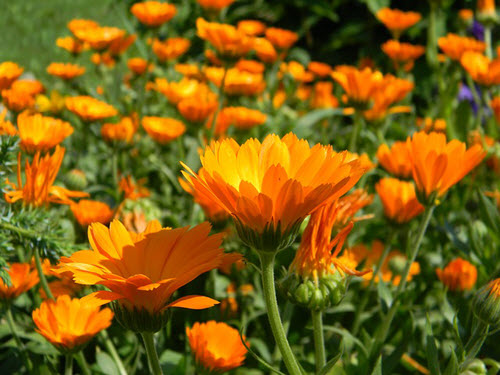
Calendula FAQ
Information about Calendula
Below are some commonly asked questions about the calendula flower, and its usage and history.
-
Where does Calendula grow?
Where does Calendula grow?
Calendula is native to southwestern Asia, western Europe, Macaronesia, and the Mediterranean. Calendula can be grown as an perennial in zones 9 and higher, and can be grown as an annual in just about any zone. -
Can you eat Calendula?
Can you eat Calendula?
The Calendula petals have been used throughout history as an edible herb, and today it is mostly used to adorn dishes, or the calendula petals can be placed in a salad. The flowers can also be used as a yellow food dye, and has been used as a saffron substitute and to color cheeses, custards, butters, sauces, etc. -
How do you pronounce Calendula?
How do you pronounce Calendula?
Calendula is pronounced [kuh-len-juh-luh], and you can hear the pronunciation at Dictionary.com: Calendula Definition and Pronunciation -
How many types of Calendula exist?
How many types of Calendula exist?
There are over 150 scientific plant names in the genus Calendula. The most common is Calendula Officinalis. There is a broad range of types of calendula, and you can see a full list here: Calendula Plant and Flowers -
What are the uses for Calendula oil?
What are the uses for Calendula oil?
Calendlula oil has been known throughout the ages for a variety of medicinal uses. It has anti-iflammatory, anti-bacterial and anti-fungal qualities. The most common use is to help with skin irritations and conditions as calendula cream, salve or ointment. You can read a broader variety of Calendula uses here:
A List of Calendula Oil Uses -
Are Calendula plants hard to grow?
Are Calendula plants hard to grow?
Calendula plants are easy to grow, and go from seed to flower quite fast. It is a forgiving plant that will produce beautiful calendula flowers and petals all year long. You can read more on growing calendula here:
Growing Calendula Plants and Flowers -
What are the uses for Calendula tea?
What are the uses for Calendula tea?
Calendula petals, both dried and recently cut, can be used to brew a healing tea for mouth and gum sores, sore throats and general use. -
How do you harvest/collect Calendula seed?
How do you harvest/collect Calendula seed?
Calendula produces a large number of seed heads. The seeds are easy to harvest once the heads dry, and you can tell when they are ready by running your thumb over the top. If the calendula seeds come loose easily just collect them in a container for planting next year. -
What is Calendula salve?
What is Calendula salve?
Calendula salve is usually made of infused calendula oil (typically olive oil) and beeswax. Salves usually have additional ingredients, like other oils, to add scent and additional healing qualities. -
Is Calendula a Marigold?
Is Calendula a Marigold?
There are two species of plants called Marigold, and they are very different plants. The French Marigold, Tagetes, is common in the garden, and an amarican native plant. Calendula Officinalis, or the Pot Marigold, is much different and has mdicinal qualities and many different variations. -
What is the history of Calendula?
What is the history of Calendula?
The ancient Romans named the plant Calendula because it seemed to bloom every first of the month (calends). The Romans and Greeks used the calendula flowers and petals in many ceremonies and rituals, and made crowns and garlands with the calendula flowers. Its nickname, Mary's Gold" or Marigold, refers to its use in many Catholic ceremonies and traditions. It is also used in Hindu ceremonies, and throughout South and Central America.